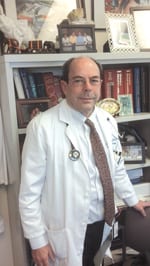Shot in the Arm Noble Hospital Strives to Raise Its Profile
George Koller likes talking about a piece of equipment that will soon arrive at Noble Hospital in Westfield. It’s a 32-slice CT scanner that creates strikingly accurate, high-resolution pictures of internal organs – a far cry from the ancient two-slice models that left plenty of tissue unobserved.
But there’s an even better machine on the horizon, a 64-slice scanner not yet available for sale. It creates holographic images so finely detailed that a doctor can navigate inside individual blood vessels, right on the computer screen, to check for plaque on the walls.
In purchasing the new 32-slice model, Koller – Noble’s president and CEO – first made sure it is upgradable to the 64-slice prototype. “That will be the ultimate imaging device, so we want to be sure we can move up to it,” he said.
It’s just one purchase, but that CT scanner is a microcosm of Noble Hospital’s strategy as it tries to become a bigger player on the Western Mass. health care scene. After all, Koller insists, a hospital shouldn’t just keep up with current technology and trends; it must constantly anticipate what’s next.
“By definition, if you’re not moving forward, you’re falling behind,” he said.
That’s why we have such a heavy agenda for the coming year.”
BusinessWest looks this issue at what’s on that agenda, and at the challenges that community hospitals like Noble face as they try to stay ahead of the changing times.
Mapping the Future
Koller admits that Noble is a hospital in flux, employing the consulting services of Cambridge Resource Institute to develop a strategic plan over the next five months.
“We’re very pleased with the input we’re getting from them, and we’re also looking for input from the community, our trustees, and our employees and medical staff,” he said. “The question is, where should Noble be in the future?”
Several ideas have already emerged, none of which may be more pressing than the need to expand the Emergency Department, a possibility under serious consideration. As a 100-bed hospital that receives some 26,000 emergency room visits per year, Koller said, Noble should ideally feature 35,000 square feet of emergency space. It currently has just 8,000 square feet.
“That’s a pressing need,” he said. “Expansion would allow us to streamline our admitting procedures and relieve some of the burdens on staff.” In addition, the computerized information management system would be upgraded, and the area’s design would better conform to the privacy standards mandated by the Health Insurance Portability and Accountability Act (HIPAA). “Right now, we just don’t have the privacy we’d like to have, and are required to have.”
Some shifts in care are around the corner as well. For one, Noble will soon incorporate a hospitalist program for inpatients, a specialty becoming more common at hospitals nationwide.
“The way things are structured in medicine, it’s difficult for an office-based physician to break out of the office and come see one or two patients in the hospital,” said Dr. Francis Horrigan, the facility’s medical director. Noble will soon launch its hospitalist program with three new doctors, whose role is to care for hospitalized patients and stay in touch with their primary care physicians.
“They will communicate effectively with the office physician so that the patient’s care is seamless,” he continued. “They’ll provide quality care in the hospital that will continue after the patient is discharged.”
Some industry observers have suggested that patients might find such a care arrangement disorienting, Horrigan said, “but if it’s well-managed and the communication is sound, patients do like it.”
State of the Art
Koller knows, however, that patients also want to receive care from skilled doctors using cutting-edge technology. To that end, Noble recently brought in a new radiology group and invested heavily in a state-of-the-art vascular laboratory. Among the lab’s sophisticated imaging equipment is a plethysmograph, which enables a doctor to map wide swaths of a patient’s vascular system with one test.
“We’re the second line of diagnosis for vascular disease, after the primary care physician,” said Dr. Paul Gagnon, assistant chief of radiology and director of the vascular lab. “If a patient has symptoms and is referred to us, we do an evaluation to see if there is significant narrowing in the vessels. We develop a road map of the vessels and determine what needs to be done.”
Not only is today’s diagnostic equipment technologically advanced, Gagnon noted, it’s easier on patients. Once-invasive angiographies are now done using CT or MRI technology, requiring a simple intravenous needle in the arm.
However, Koller said, a hospital needs to do more than utilize advanced equipment; in a highly competitive marketplace, it also needs to market that technology to the community. And Koller sees opportunities to do just that while bringing attention to his medical staff – celebrating them, as he puts it.
“We have great physicians and great technology, and we want to make sure the community knows this,” he told BusinessWest. To that end, Noble has launched a physician lecture series, open to the public, on various Tuesday evenings at 6:30 p.m. throughout the fall.
“It’s one way to highlight the medical staff while discussing topics that our physicians feel the general public will be interested in,” Koller said. “We want to educate people. I see us becoming a premier community hospital, and we want to show people what we have behind these four walls.”
As Westfield continues to grow, Koller added, families will have greater needs not only for hospital care but for primary care physicians and specialists as well. “We would like to see a medical office building on campus at some point. It would make life easier for both doctors and patients.”
Facing the Challenges
Of course, the fiscal forces that make life more difficult for hospitals are well-documented, and not going away any time soon. Medicare and Medicaid reimbursement – what providers are compensated for their services – continues to hover around 70 cents on the dollar.
At the same time, “insurance companies continue to be very frugal in how they spend money,” Koller said. “We’ve seen very small increases in fees to hospitals and physicians.”
Meanwhile, hospitals have little answer right now for the problem of uncompensated care, which is the free emergency care given to the uninsured and underinsured. The state and insurance companies now cover about half of that cost, but the rest of the burden falls on the already cash-strapped hospitals themselves.
“Our mission is to take care of patients regardless of their ability to pay; we do it all the time,” Koller said. “But when large numbers of free-care patients come through, we can’t cover the costs.
“How do we survive in this market where everyone is paying less than our costs?” he continued, before answering his own question. “By keeping costs down and bringing in greater volume. We have lots of flexibility in our structure, so we’re able to take on more patients.”
That desire – to treat more Greater Westfield residents and to give them continually better care – is at the heart of Noble Hospital’s still-developing strategic plan, one intended to strengthen the hospital financially while positioning it as a major player.
“We’re happy with what we’re seeing,” Koller said, “and we’ll continue moving forward.”
As he said himself, the alternative is falling behind. And in today’s health care climate, that’s not an option. v



Comments are closed.